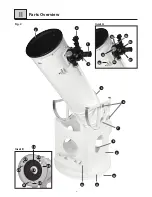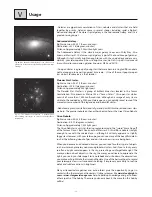
- 14 -
V
Useful Tips
Because of the Earth's rotation all objects in a telescope's eyepiece will seem to drift across the
field of view. To compensate for this movement you have to move the telescope smoothly
and slowly. The higher the magnification the more accurate this tracking movement has to
be. Another solution is to place the object on the eastern rim of the field of view and let it drift
across the field, then reposition it on the eastern rim again. NOTE: This method only works
with good eyepieces that are delivering a sharp image up to the edge of the field.
Vibrations: Avoid touching the eyepiece during observations because even the slightest
movement in your hand can cause unsteady views.
Dark adaption: Give your eyes some time to adapt to the darkness. This takes about 20-30
minutes after an exposure to a bright light – even if it is a short exposure. Use a dim light with
a red filter to read star charts or draw objects.
Planets and other objects that are close to the horizon are severely influenced by air turbulence
and absorbance. It is much better to time your observations in a way that those objects are
close to the meridian, so that they are at their highest position possible. If the image is dim
or moving fast, use a smaller magnification. Using too much magnification is a mistake that is
made very often by beginners.
Warm clothing: Even in the summer the nights may get very cold during clear nights,
especially on the mountains. Always remember to bring warm clothing like thick jackets,
beanies, gloves, winter shoes and thick socks – even if your were sweating during the day. It
is hard to enjoy even the best night when you are freezing!
Explore your observing site during the day: The ideal site should be far away from
frequently used streets and other light sources that would prevent your eyes to become dark
adapted. Keep in mind that it is likely to get foggy in the vicinity of open water, such as river
valleys or lakes. The ground should be solid and relatively flat. You can observe in the city, but
try to get to a place some distance away, where you can see the Milky Way if possible.
Usage


























